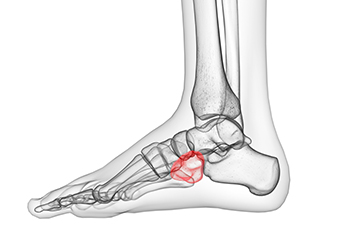Yakima
(509) 225-3668
Ellensburg
(509) 925-4633

Cuboid syndrome occurs when the cuboid bone in the foot becomes partially dislocated, a situation known as subluxation. The cuboid bone is located on the outer side of the foot, between the heel and the base of the fourth and fifth toes, playing a vital role in stabilizing the foot and supporting movement. Causes of cuboid syndrome include sudden injuries like ankle sprains, repetitive stress from activities like running or jumping, and wearing poorly fitting shoes that place extra pressure on the foot. Symptoms typically involve pain on the outer side of the foot, difficulty walking, tenderness, and swelling. Sometimes the pain can radiate into the toes or up the leg. If you have pain in this part of your foot, it is suggested that you consult a podiatrist who can accurately diagnose and offer treatment options.
Cuboid syndrome, also known as cuboid subluxation, occurs when the joints and ligaments near the cuboid bone in the foot become torn. If you have cuboid syndrome, consult with one of our podiatrists from Cascade Foot & Ankle. Our doctors will assess your condition and provide you with quality foot and ankle treatment.
Cuboid syndrome is a common cause of lateral foot pain, which is pain on the outside of the foot. The condition may happen suddenly due to an ankle sprain, or it may develop slowly overtime from repetitive tension through the bone and surrounding structures.
Causes
The most common causes of cuboid syndrome include:
Symptoms
A common symptom of cuboid syndrome is pain along the outside of the foot which can be felt in the ankle and toes. This pain may create walking difficulties and may cause those with the condition to walk with a limp.
Diagnosis
Diagnosis of cuboid syndrome is often difficult, and it is often misdiagnosed. X-rays, MRIs and CT scans often fail to properly show the cuboid subluxation. Although there isn’t a specific test used to diagnose cuboid syndrome, your podiatrist will usually check if pain is felt while pressing firmly on the cuboid bone of your foot.
Treatment
Just as the range of causes varies widely, so do treatments. Some more common treatments are ice therapy, rest, exercise, taping, and orthotics.
If you have any questions, please feel free to contact our offices located in Yakima and Ellensburg, WA . We offer the newest diagnostic and treatment technologies for all your foot care needs.